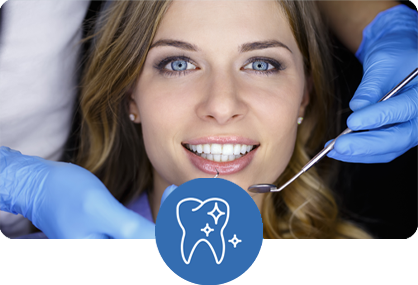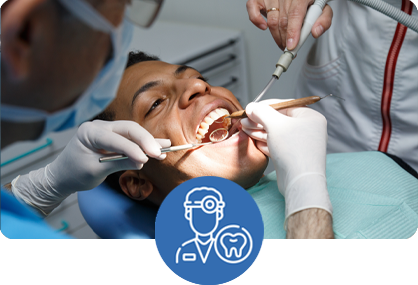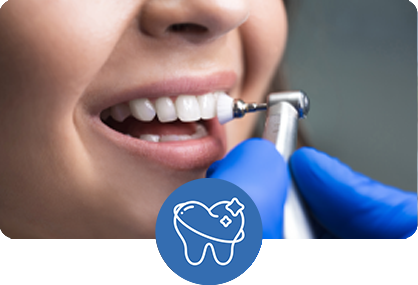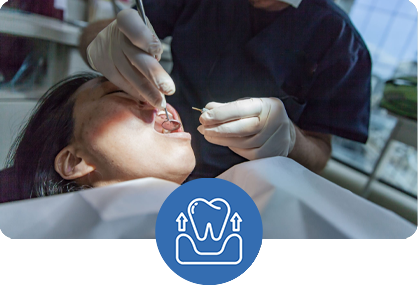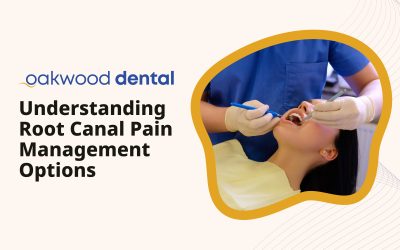- Dental crowns are caps that restore damaged teeth, while bridges replace missing teeth
- Different materials offer varying benefits: porcelain/ceramic for aesthetics, zirconia for strength
- Longevity varies: crowns typically last 10-15 years, bridges 5-15 years
- Proper maintenance significantly extends the lifespan of both restorations
- Regular dental checkups are essential for monitoring restoration health
Introduction to Dental Restorations
Dental crowns and bridges are two common options that fix your smile, but they serve different purposes. At Oakwood Dental Clinics, we provide complete restorative solutions based on your specific needs. Our team works hard to make sure each restoration works well and looks good too.
Dental crowns are custom-made caps placed over damaged teeth. They’re often used when a tooth is badly decayed, cracked, or weakened by large fillings or root canal treatment. These protective coverings wrap around the entire visible part of the tooth above the gumline, making the tooth stronger while improving how it looks and works.
Understanding the differences between these options is important for making a good decision about your dental health. In this article, we’ll look at the various types of crowns and bridges, what they’re made of, how long they last, and how to take care of them. We’ll also talk about how they affect your oral health in the long run, helping you figure out which option might be best for you.
Types of Dental Crowns
Dental crowns come in several types, each with its own benefits. Comparing dental crown types can help you understand which option might be right for you. The best choice depends on where the tooth is located, what it needs to do, and what you prefer it to look like.
Full Crowns
Full crowns cover the entire visible part of a tooth above the gum line. They’re the most common type and are used when a large part of the tooth is damaged or missing. At Oakwood Dental Clinics, we make sure full crowns match your natural teeth in color and shape. These restorations completely protect damaged teeth while restoring how they work and look. The process involves removing a layer of the original tooth to make room for the crown.
Partial Crowns (Onlays and 3/4 Crowns)
When only part of the tooth needs fixing, partial crowns like onlays or 3/4 crowns may be better. These keep more of your natural tooth while still protecting and strengthening the damaged areas. Onlays cover the chewing surface and extend over one or more cusps, while 3/4 crowns cover more of the tooth but leave one surface (usually the visible surface) intact. This approach saves healthy tooth structure while fixing specific damaged areas.
Temporary vs. Permanent Crowns
Temporary crowns are placed while your permanent crown is being made in a dental laboratory. They’re typically made of acrylic or stainless steel and aren’t meant for long-term use. CEREC technology at our clinic allows us to create permanent crowns in a single visit, removing the need for temporary crowns in many cases. This advanced technology uses digital scans to design and mill a custom crown from ceramic material while you wait, cutting treatment time from multiple appointments to just a few hours. The result is a precise, durable restoration that matches your natural teeth.
Types of Dental Bridges
Dental bridges come in several types, each designed to address specific tooth replacement needs. Understanding these options can help you decide which type might work better for you, based on how many teeth you’re missing, where they’re located, the condition of nearby teeth, and your budget.
Traditional Bridges
Traditional bridges involve creating crowns for the teeth on both sides of the gap with an artificial tooth in between. This is the most common type of bridge and is used when there are natural teeth on both sides of the gap. The supporting teeth must be strong and healthy enough to support the bridge. Traditional bridges provide good stability and can effectively restore both function and looks, though they do require changing otherwise healthy adjacent teeth.
Maryland Bridges
Maryland bridges use metal or porcelain frameworks that are bonded to the backs of adjacent teeth, requiring less change to the supporting teeth. They’re often used to replace front teeth and are less invasive than traditional bridges. This approach preserves more natural tooth structure, making it especially good for younger patients or those with otherwise healthy adjacent teeth. However, Maryland bridges are generally less durable than traditional bridges and may not be appropriate for teeth that experience significant biting forces.
Cantilever Bridges
When there are healthy teeth on only one side of the gap, cantilever bridges may be an option. These are anchored to one or more teeth on just one side of the missing tooth space. However, they’re generally not recommended for back teeth where they might create too much force on the supporting teeth. Cantilever bridges can be useful in specific situations, such as replacing a lateral incisor with a canine serving as the support tooth, but they must be carefully designed to avoid creating damaging forces.
Implant-Supported Bridges
Implant-supported bridges use dental implants as anchors rather than natural teeth. They offer excellent stability and help prevent bone loss in the jaw. This option is ideal for patients missing multiple teeth in a row who have enough bone density for implant placement. Implant-supported bridges distribute biting forces more naturally than traditional bridges and don’t require changing adjacent healthy teeth. While initially more costly and time-consuming, they often provide better long-term value and oral health benefits.
Materials Used in Dental Restorations
The material chosen for your dental restoration affects how it looks, how long it lasts, and how it works with your oral health. At Oakwood Dental Clinics, we offer various materials to suit different needs, from highly aesthetic options for front teeth to extremely durable materials for back teeth that handle heavy chewing. Our dental professionals will help you pick the most appropriate material based on where the restoration will go, your budget, and your expectations for how it will look.
Porcelain and Ceramic
Porcelain and ceramic crowns and bridges provide the most natural appearance, closely matching the color and translucency of natural teeth. They’re an excellent choice for front teeth where looks are especially important. These materials are also biocompatible, making them suitable for patients with metal allergies. Modern ceramic materials like lithium disilicate offer improved strength compared to traditional porcelain while maintaining excellent aesthetic properties. These restorations can be customized with various shades, translucencies, and surface characteristics to create a truly lifelike appearance.
Porcelain-Fused-to-Metal (PFM)
PFM restorations combine the natural appearance of porcelain with the strength of a metal base. They offer a good balance of looks and durability, making them suitable for both front and back teeth. However, the metal may sometimes show through as a dark line near the gum line, especially if gum recession occurs over time. PFM restorations have been used successfully for decades and have a proven track record of reliability. They’re often more affordable than all-ceramic options while still providing good aesthetics and excellent functional properties.
Zirconia
Zirconia crowns and bridges offer exceptional strength and durability while maintaining a natural appearance. This material is highly resistant to fracture and wear, making it an excellent option for back teeth that handle significant chewing forces. Zirconia is also biocompatible and less likely to cause sensitivity. Recent advances in zirconia formulations have improved its translucency, allowing it to be used for front teeth as well. This versatile material can be layered with porcelain for enhanced aesthetics or used in its solid form for maximum strength.
Metal Alloys
Gold alloys and base metal alloys (such as nickel-chromium and cobalt-chromium) provide superior strength and durability. While not as pretty as tooth-colored options, metal restorations require less tooth reduction and are highly resistant to wear and fracture. They’re often recommended for molars that aren’t visible when smiling. Gold alloys in particular have excellent biocompatibility and wear properties that closely match natural tooth enamel, preventing excessive wear on opposing teeth. For patients who care more about function than looks for back teeth, metal alloys remain an excellent choice.
Procedure Comparison
Understanding what to expect during crown and bridge procedures can help reduce anxiety and prepare you for the treatment process. Both procedures typically require multiple appointments, though advanced technologies like CEREC can sometimes condense the process into a single visit for certain restorations.
Crown Procedure
The crown procedure typically involves:
1. Examination and preparation: Your dentist will examine the tooth and prepare it by removing decay and shaping it to fit the crown. This involves reducing the tooth structure by about 1-2mm on all surfaces to create space for the crown material. Local anesthesia ensures you’re comfortable throughout this process. Digital or 3D imaging may be used to assess the tooth and plan the preparation.
2. Impressions: Digital or physical impressions are taken to create a custom crown that fits perfectly. Digital impressions using intraoral scanners provide highly accurate measurements without the discomfort sometimes associated with traditional impression materials. These impressions capture the prepared tooth, adjacent teeth, and opposing teeth to ensure proper fit and bite alignment.
3. Temporary crown placement: If not using CEREC same-day technology, a temporary crown is placed while the permanent one is being made. This temporary restoration protects the prepared tooth and maintains spacing while the dental laboratory creates your custom crown, a process that typically takes 1-2 weeks. Temporary crowns require special care to avoid coming loose.
4. Permanent crown placement: The final crown is checked for fit and appearance before being cemented in place. Your dentist will evaluate the edges, contacts with adjacent teeth, and bite to ensure proper function. Minor adjustments may be made before the crown is permanently bonded using dental cement. After placement, your dentist will provide care instructions to help maintain your new restoration.
Bridge Procedure
The bridge procedure generally involves:
1. Preparation of abutment teeth: The teeth on either side of the gap are prepared to receive crowns that will support the bridge. This preparation is similar to that for individual crowns, involving reduction of tooth structure to accommodate the restoration. For implant-supported bridges, this step involves either placing new implants or preparing existing implants to receive the bridge structure.
2. Impressions: Precise impressions are taken to create a custom-fitted bridge. These impressions capture not only the prepared teeth but also the space between them where the artificial tooth will be placed. The impression must accurately reflect the relationship between the supporting teeth and the surrounding oral structures to ensure a properly fitting bridge.
3. Temporary bridge placement: A temporary bridge protects the exposed teeth and gums while the permanent bridge is being made. This provisional restoration maintains spacing and provides some aesthetic and functional benefit during the fabrication period. Patients are instructed on how to clean around the temporary bridge and which foods to avoid.
4. Bridge fitting and adjustment: The permanent bridge is checked for proper fit and adjusted as needed before final cementation. This involves evaluating the fit of the crowns on the supporting teeth, the appearance and position of the artificial tooth, and the bite relationship with opposing teeth. After any necessary adjustments, the bridge is permanently cemented or bonded in place.
For implant-supported bridges, the process includes additional steps for implant placement and healing before the bridge is attached. This typically extends the overall treatment timeline to several months but results in a restoration that doesn’t require modification of natural teeth.
Durability and Longevity
How long dental restorations last depends on various factors, including the materials used, your oral hygiene habits, and whether you have habits like teeth grinding or clenching. Understanding the expected lifespan of different restorations can help you make informed decisions and develop good maintenance strategies.
Crown Longevity
On average, dental crowns last between 10 and 15 years, though some can last much longer with proper care. Factors affecting crown longevity include:
– Material type (metal crowns tend to last longer than all-porcelain ones, with gold alloys potentially lasting 20+ years)
– Location in the mouth (back teeth experience more force and may wear faster)
– Oral hygiene practices (regular brushing, flossing, and professional cleanings extend lifespan)
– Habits such as teeth grinding or using teeth as tools (which can damage or fracture crowns)
– Diet choices (avoiding extremely hard foods that could fracture ceramic materials)
– Regular professional maintenance and prompt attention to any issues
Bridge Longevity
Traditional bridges typically last between 5 and 15 years, while implant-supported bridges can last 15 years or more. The longevity of a bridge depends on:
– The type of bridge (implant-supported bridges generally last longer than traditional bridges)
– Materials used in construction (similar to crowns, metal and zirconia tend to be more durable)
– Health of the supporting teeth or implants (gum disease or implant complications can compromise the bridge)
– Oral hygiene practices, particularly cleaning under the artificial tooth (specialized flossing tools and interdental brushes are essential)
– Diet and habits that could damage the bridge (avoiding sticky foods and not using teeth as tools)
– Regular professional evaluations to detect and address issues early
Factors Affecting Restoration Longevity
- Oral Hygiene: Daily brushing, flossing, and regular professional cleanings to prevent decay and gum disease around restoration margins
- Diet: Limiting sticky, hard foods and sugary beverages that can damage restorations or promote decay in surrounding tooth structure
- Habits: Avoiding teeth grinding, nail biting, and using teeth as tools which place excessive stress on dental restorations
Maintenance Requirements
Proper maintenance is crucial for extending the life of your dental restorations and maintaining overall oral health. Both crowns and bridges require specific care routines to ensure their longevity and performance. Following these maintenance guidelines can help prevent problems and avoid costly replacements.
Daily Care for Crowns
Caring for crowned teeth involves:
– Brushing twice daily with a soft-bristled toothbrush using gentle, circular motions around all surfaces of the crown. Non-abrasive, fluoride toothpaste helps prevent decay at the crown margins while avoiding scratches on the restoration surface.
– Flossing daily, paying special attention to the crown margins where the restoration meets the natural tooth structure. This area is particularly vulnerable to decay and requires thorough but gentle cleaning. Special floss designed for crown margins can be helpful.
– Using an antimicrobial mouthwash to reduce bacteria and help prevent gum inflammation around the crown. Alcohol-free formulations are preferable to avoid degrading the cement over time.
– Avoiding excessive force on the crowned tooth, particularly when eating hard foods or if you have habits like teeth grinding. A night guard may be recommended if you clench or grind your teeth during sleep.
Special Care for Bridges
Bridges require additional care, including:
– Using floss threaders or interdental brushes to clean under the artificial tooth and around the supporting teeth. This specialized cleaning is essential as regular flossing cannot reach under the artificial tooth where food and plaque can build up. Super floss with a stiffened end or specialized bridge flossers can make this task easier.
– Water flossers to help remove debris from hard-to-reach areas, providing a powerful yet gentle cleaning action that can reach under artificial teeth and around supporting teeth. Different pressure settings and specialized tips can enhance cleaning effectiveness for bridge structures.
– Regular professional cleanings to maintain the health of supporting teeth and surrounding gum tissue. Dental hygienists have specialized tools and techniques to clean areas that are difficult to reach with home care methods.
– Avoiding sticky foods that could dislodge the bridge, such as caramels, taffy, and certain types of gum. Hard foods like nuts and ice should be eaten carefully to avoid damaging the bridge structure.
Regular dental checkups are essential for both crowns and bridges to detect any issues early and ensure the restorations remain in good condition. During these visits, your dentist will check for signs of wear, decay around margins, cement integrity, and proper bite alignment.
Functional Considerations
When deciding between crowns and bridges, it’s important to think about how each option will work in your specific situation. Functional aspects include chewing efficiency, speech impacts, and overall comfort—all of which affect your daily quality of life with the restoration.
Chewing Efficiency
Both crowns and bridges can restore normal chewing function, but there are some differences:
– Crowns preserve natural tooth structure and maintain normal bite dynamics by restoring the original tooth’s shape and function. Since they’re anchored to your natural tooth root, they provide excellent stability and proprioception (the sense of pressure and position), allowing for more natural chewing sensations and efficient mastication.
– Bridges distribute chewing forces across multiple teeth, which can be good or bad depending on the health of supporting teeth. This distribution means that supporting teeth bear additional load, which can be problematic if these teeth are already compromised. However, it can also provide stability for the entire dental arch.
– Implant-supported bridges provide chewing efficiency most similar to natural teeth because dental implants mimic the function of tooth roots. The titanium implants fuse with jawbone (osseointegration), creating a stable foundation that transfers chewing forces to the bone in a manner similar to natural teeth, helping to preserve bone density.
Speech Impacts
Dental restorations can affect speech patterns, particularly when front teeth are involved:
– Well-fitted crowns typically have minimal impact on speech since they closely replicate the original tooth’s dimensions and contours. Modern crown materials and fabrication techniques allow for precise reproduction of tooth morphology, preserving normal phonetics and articulation patterns.
– New bridges may require a short adjustment period as you get used to speaking with the restoration. The presence of the artificial tooth, especially in the front of the mouth, can initially affect the production of certain sounds like “s,” “z,” “t,” and “d.” Most patients adapt within a few days to weeks as the brain adjusts to the new oral environment.
– If a bridge doesn’t fit properly, it can cause whistling or slurring, which should be addressed by your dentist at Oakwood Dental Clinics. These speech issues often indicate improper contours or spacing that can be corrected through adjustments to the restoration.
Comfort Levels
The comfort of your restoration depends on proper fit and adaptation:
– Crowns should feel natural and comfortable after a brief adjustment period of a few days. Initially, you may notice some sensitivity to temperature or pressure, but this typically resolves as the tooth pulp adapts to the restoration. A properly fitted crown should eventually feel just like your natural teeth.
– Bridges may feel bulkier initially, especially under the artificial tooth area where it meets the gum tissue. This sensation usually diminishes as you adapt to the restoration. The design of the artificial tooth—particularly how it contacts the gum tissue—significantly affects comfort. Modern ovate pontics that slightly indent the gum provide both aesthetic and comfort benefits.
– Any persistent discomfort, sensitivity, or pain should be evaluated by your dentist at Oakwood Dental Clinics. These symptoms could indicate issues with fit, bite alignment, or underlying dental problems that require attention.
Aesthetic Considerations
The appearance of your dental restorations plays a big role in how happy you are with the treatment. Modern dental materials and techniques allow for highly natural-looking results that can improve your smile while restoring function.
Natural Appearance
Modern dental materials allow for highly natural-looking restorations:
– All-ceramic and porcelain restorations offer the most natural appearance, especially for front teeth. These materials can be customized to match the exact shade, translucency, and surface characteristics of your natural teeth. Advanced ceramics like lithium disilicate and layered zirconia can replicate the depth and light-reflecting properties of natural enamel and dentin.
– PFM restorations provide a good balance of aesthetics and strength. While not as translucent as all-ceramic options, modern PFM crowns and bridges can still achieve excellent aesthetic results, particularly with improved porcelain layering techniques that create more natural light transmission.
– The skill of the dental technician and dentist significantly impacts the final appearance. Artistic considerations like surface texture, translucency gradients, and anatomical contours require expertise to reproduce. Digital smile design and advanced laboratory communication techniques help achieve optimal aesthetic outcomes.
Color Matching
Getting a perfect color match with your natural teeth requires:
– Professional shade matching under various lighting conditions to account for how different light sources affect tooth appearance. Natural daylight, fluorescent light, and incandescent light can all reveal different aspects of tooth color.
– Consideration of the natural translucency and characteristics of your teeth, including surface texture, enamel thickness variations, and individual color zones. Advanced shade-taking technologies like digital spectrophotometers can capture these subtle variations more accurately than traditional shade guides.
– Potential teeth whitening before restoration to achieve desired overall color. This approach ensures a more harmonious result, as restorations cannot be whitened after fabrication. If you’re planning to whiten your teeth, it’s best to do so before getting new restorations.
Gum Tissue Considerations
The relationship between your restoration and gum tissue affects both aesthetics and health:
– Crown margins should be properly placed and polished to prevent gum irritation and ensure a seamless transition between the restoration and natural tooth. Ideally, margins should be slightly subgingival (below the gumline) in aesthetic areas while remaining accessible for cleaning.
– Bridge pontics should be designed to appear as if they’re emerging naturally from the gums. Modern pontic designs like modified ridge lap or ovate pontics create the illusion that the artificial tooth is growing from the gumline, enhancing the natural appearance of the restoration.
– Regular hygiene is essential to maintain healthy gum tissue around restorations. Inflammation or recession can expose margins and compromise aesthetics. Proper emergence profiles and highly polished restoration surfaces help maintain gum health by minimizing plaque accumulation.
“The goal of modern restorative dentistry is not just to repair teeth, but to create restorations that are indistinguishable from natural teeth in both function and appearance.”
Long-term Oral Health Impacts
The choice between crowns and bridges can have lasting effects on your overall oral health. Understanding these potential impacts can help you make decisions that support not only your immediate needs but also your long-term dental well-being.
Effects on Adjacent Teeth
– Crowns preserve the natural tooth structure they cover but may require significant reduction of the original tooth to accommodate the restoration material thickness. Modern preparation techniques and materials allow for more conservative approaches, but some healthy tooth structure is inevitably removed. This preparation can sometimes lead to pulpal irritation or the need for root canal therapy in some cases.
– Traditional bridges require altering healthy adjacent teeth to support the bridge, which involves removing enamel and sometimes dentin from teeth that might otherwise be untouched. This irreversible process can potentially compromise these teeth in the long term, making them more susceptible to decay or fracture if the bridge fails.
– Maryland bridges are more conservative but may not be suitable for all situations due to their limited strength and specific bonding requirements. They preserve more tooth structure of the abutment teeth but may not withstand significant biting forces, particularly in the posterior region.
– Implant-supported restorations preserve adjacent teeth but require adequate bone structure and a surgical procedure. They offer the advantage of not requiring modification of healthy adjacent teeth while providing excellent long-term support and function.
Bone Preservation
When teeth are missing, the underlying jawbone can begin to deteriorate:
– Crowns don’t address bone preservation if the natural tooth root is gone. While they excellently restore the visible portion of the tooth, they cannot prevent the bone resorption that occurs after tooth extraction unless placed on a dental implant.
– Traditional bridges don’t prevent bone loss in the area of the missing tooth because they don’t replace the tooth root. Over time, this bone resorption can lead to changes in facial structure and potentially affect the fit and appearance of the bridge.
– Implant-supported restorations help preserve bone by stimulating it similar to natural tooth roots. The titanium implant integrates with the jawbone through osseointegration, providing the mechanical stimulation necessary to maintain bone density and volume. This preservation of bone structure has significant long-term benefits for facial aesthetics and oral function.
Future Replacement Considerations
All dental restorations eventually need replacement:
– When crowns need replacement, the procedure is relatively straightforward, though it often requires further reduction of the underlying tooth structure. Each replacement cycle typically results in a slightly larger crown and less natural tooth structure, which can eventually impact the tooth’s prognosis.
– Replacing bridges can be more complex, especially if supporting teeth have developed issues such as decay or periodontal disease. The condition of the abutment teeth largely determines whether a similar bridge can be placed or if alternative solutions must be considered.
– Planning for eventual replacement should be part of your long-term dental strategy. Discussing potential future scenarios with your dentist can help you make choices that preserve options for when the current restoration reaches the end of its useful life.
Signs Your Restoration May Need Attention
- Persistent pain or sensitivity that doesn’t resolve within a few weeks
- Visible chips, cracks, or wear that compromise function or aesthetics
- Dark line appearing at the gum line, potentially indicating margin leakage or recession
- Restoration feels loose or moves slightly when touched or during chewing
- Changes in your bite or how teeth fit together, suggesting wear or shifting
Making Your Decision
Choosing between a crown and a bridge depends on your specific dental situation, preferences, and long-term oral health goals. This decision should be made together with your dental professional after thorough examination and discussion of all available options.
Consultation Process
At Oakwood Dental Clinics, our comprehensive consultation process includes:
– Thorough examination of your teeth, gums, and supporting structures using advanced diagnostic tools including digital radiographs, intraoral cameras, and possibly 3D imaging. This comprehensive assessment provides a complete picture of your oral health status and helps identify the most appropriate treatment options.
– Discussion of your goals and concerns regarding function, aesthetics, timeline, and budget. We believe in patient-centered care where your priorities and expectations are central to the treatment planning process. Our team takes time to understand what matters most to you in your dental restoration.
– Presentation of appropriate treatment options with their benefits and limitations, including detailed explanations of materials, procedures, expected outcomes, and maintenance requirements. We provide clear information about costs, insurance coverage, and financing options to help you make an informed financial decision.
– Digital imaging to help visualize potential outcomes, allowing you to preview the expected results of different treatment approaches. This may include digital smile design technology that shows how various restorations would look in your specific situation.
Questions to Ask Your Dentist
To make an informed decision, consider asking:
– Which option will provide the best long-term outcome for my specific situation? Consider factors like your age, overall dental health, and whether you have conditions that might affect restoration success, such as grinding or clenching habits.
– How will each option affect my remaining natural teeth? Understanding the impact on adjacent and opposing teeth can help you evaluate the comprehensive effects of each treatment approach.
– What are the maintenance requirements for each option? Some patients may prefer simpler maintenance routines, while others are willing to perform more complex care procedures for better long-term outcomes.
– What is the expected lifespan of each restoration? Knowing the anticipated durability can help you assess the value proposition of different options, especially when considering the initial investment.
– Are there any lifestyle adjustments I should make with either option? Certain activities or dietary habits might affect the success and longevity of different restorations.
Decision Factors Comparison
| Factor | Crowns | Bridges |
|---|---|---|
| Preserves natural teeth | Yes (the tooth being crowned) | Requires modification of adjacent teeth |
| Replaces missing teeth | No | Yes |
| Prevents teeth shifting | No | Yes |
| Preserves jawbone | No (unless on implant) | No (unless implant-supported) |
| Maintenance difficulty | Standard oral hygiene | Requires special cleaning tools |
Conclusion
When comparing dental crowns and bridges, there’s no one-size-fits-all answer. Each option offers distinct advantages depending on your specific dental needs, oral health status, and personal preferences. The decision should be made in consultation with your dental professional after careful consideration of all relevant factors.
Dental crowns excel at restoring and protecting damaged teeth while preserving the natural tooth root and its connection to the jawbone. They’re ideal when you have a tooth that’s structurally compromised but still salvageable, offering long-term durability that can span 10-15 years or more with proper care. Modern crown materials like zirconia and advanced ceramics provide both strength and natural aesthetics, making them suitable for any position in your mouth.
Bridges, on the other hand, provide an effective solution for replacing one or more missing teeth without the need for surgical procedures. Traditional bridges offer reliable restoration of function and appearance, though they do require modification of adjacent teeth. For those seeking the most conservative and long-lasting solution, implant-supported bridges combine the benefits of dental implants with bridge technology, preserving healthy tooth structure while preventing bone loss.
Regardless of which option you choose, success depends heavily on proper maintenance and regular professional care. Daily brushing and flossing, along with specialized cleaning techniques for bridges, will significantly extend the life of your restoration. Regular dental checkups allow your dentist to monitor the health of your restoration and address any issues before they become serious problems.
At Oakwood Dental Clinics, we’re committed to helping you make the best decision for your unique situation. Our experienced team will guide you through the options, answer your questions, and provide the highest quality care throughout your treatment journey. Whether you need a single crown or a complex bridge, we have the expertise and technology to deliver results that restore both function and confidence to your smile.
Remember, investing in quality dental restorations today can prevent more extensive and costly treatments in the future. By choosing the right solution and maintaining it properly, you’re not just fixing a dental problem—you’re investing in your long-term oral health and overall quality of life.

 718-979-2121
718-979-2121

